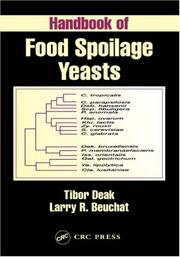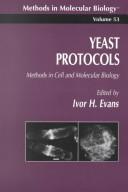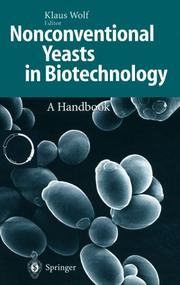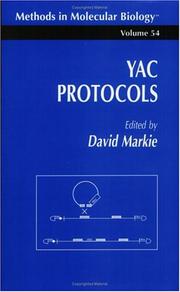| Listing 1 - 7 of 7 |
Sort by
|

Abstract | Keywords | Export | Availability | Bookmark
 Loading...
Loading...Choose an application
- Reference Manager
- EndNote
- RefWorks (Direct export to RefWorks)
Food spoilage --- Food --- Yeast fungi --- Microbiology
Book
ISBN: 907565202X 9789075652024 Year: 1996 Volume: 23,3 23,3 Publisher: Bruxelles : Académie royale des sciences d'Outre-Mer [ARSOM] = Koninklijke academie voor overzeese wetenschappen [KAOW] = Royal academy of overseas sciences,
Abstract | Keywords | Export | Availability | Bookmark
 Loading...
Loading...Choose an application
- Reference Manager
- EndNote
- RefWorks (Direct export to RefWorks)
Biochemie --- Biochimie --- Cryptococcose --- Cryptococcosis --- Cryptococcus neoformans --- Microbiologie --- Torulosis --- Yeast fungi --- Tropics --- Pathogene schimmels --- Algues --- Kisangani (zaire)
Dissertation
Year: 1996 Publisher: Bruxelles Gembloux Communauté française de Belgique Faculté universitaire des sciences agronomiques de Gembloux
Abstract | Keywords | Export | Availability | Bookmark
 Loading...
Loading...Choose an application
- Reference Manager
- EndNote
- RefWorks (Direct export to RefWorks)
Apple --- Postharvest diseases and injuries --- Botrytis cinerea --- Antagonists --- Yeast fungi --- Biotechnology
Book
ISBN: 9075652011 9789075652017 Year: 1996 Volume: 23,2 23,2 Publisher: Bruxelles : Académie royale des sciences d'Outre-Mer [ARSOM] = Koninklijke academie voor overzeese wetenschappen [KAOW] = Royal academy of overseas sciences,
Abstract | Keywords | Export | Availability | Bookmark
 Loading...
Loading...Choose an application
- Reference Manager
- EndNote
- RefWorks (Direct export to RefWorks)
Afrika --- Afrique --- Cryptococcose --- Cryptococcosis --- Cryptococcus neoformans --- Ecologie --- Microbiologie --- Torulosis --- Yeast fungi --- Tropics --- Pathogene schimmels --- Rusizi (riviere, burundi) --- Vegetation --- Dynamique --- Burundi

ISBN: 9780896033191 0896033198 9781592595402 9786610836628 1280836628 1592595405 Year: 1996 Volume: 53 Publisher: Totowa, NJ : Humana Press : Imprint: Humana,
Abstract | Keywords | Export | Availability | Bookmark
 Loading...
Loading...Choose an application
- Reference Manager
- EndNote
- RefWorks (Direct export to RefWorks)
Yeast Protocols intends to offer a selection of well-proven proto cols in cell and molecular biology, applicable to yeasts including, but certainly not exclusively aimed at, Saccharomyces cerevisiae. Saccharomyces cerevisiae and its very distant cousin, Schizosacc- romyces pombe, are of course now foremost model eukaryotic organisms, and the focus of wide-ranging experimental studies, especially those using molecular genetic techniques. Many of the lat ter, such as DNA sequencing and in vitro mutagenesis, are general DNA techniques, well covered in other volumes of Humana's Meth ods in Molecular Biology series, and elsewhere. The inclusion of a number of non-DNA techniques in this book is meant to reflect the resurgent interest in yeast cell biology sparked by the development of gene manipulation methods—for example, cellular localization of cloned gene products using microscopical techniques. The presentation of protocols follows the successful Methods in Molecular Biology series format, with a clear sequence of steps and extensive troubleshooting notes. It is our hope that these protocols will be useful not only to established members of the full-time research community, but also to the less experienced—first degree level and masters students undertaking project work, as well as PhD students starting their experimental programs; I am well aware that these young apprentice scientists are not always able to receive the supervision time that they, and indeed their supervisors, would like.
Yeasts --- Yeast fungi --- Levures (Botanique) --- physiology --- isolation & purification --- cytology --- Biotechnology --- Research --- Methodology --- Biotechnologie --- Yeast --- -Yeast fungi --- -Yeasts --- Fungi --- Basidiomycetes --- Blastomycetes --- Endomycetales --- Nematospora --- Edible fungi --- Leavening agents --- Yeast-free diet --- -Methodology --- Biotechnology. --- Methodology. --- physiology. --- cytology. --- isolation & purification. --- -Biotechnology --- Cytology. --- Isolation & purification. --- Physiology. --- Yeast biotechnology --- Microbial biotechnology --- Yeast industry --- Research&delete& --- Cell Biology. --- Cell biology --- Cellular biology --- Biology --- Cells --- Yeast fungi - Research - Methodology --- Yeast - Biotechnology

ISBN: 3540594825 9783540594826 3642798586 364279856X Year: 1996 Publisher: Berlin : Springer,
Abstract | Keywords | Export | Availability | Bookmark
 Loading...
Loading...Choose an application
- Reference Manager
- EndNote
- RefWorks (Direct export to RefWorks)
Yeast fungi --- Biotechnology --- Handbooks, manuals, etc. --- Levure --- Yeasts --- Biotechnologie --- Classification --- classification --- Biodiversité --- Biodiversity --- Kluyveromyces marxianus --- Pichia --- Yarrowia lipolytica --- Candida maltosa --- 663.12 --- -Yeasts --- Fungi --- Basidiomycetes --- Blastomycetes --- Endomycetales --- Yeasts in general. Brewing yeast. Ascending and descending yeasts --- -Handbooks, manuals, etc --- 663.12 Yeasts in general. Brewing yeast. Ascending and descending yeasts --- -Yeasts in general. Brewing yeast. Ascending and descending yeasts --- -663.12 Yeasts in general. Brewing yeast. Ascending and descending yeasts --- classification. --- Yeast fungi - Biotechnology - Handbooks, manuals, etc. --- Schwanniomyces occidentalis --- Arxula adeninovorans

ISBN: 9780896033139 0896033139 9781592595419 9786610836635 1280836636 1592595413 Year: 1996 Publisher: Totowa, NJ : Humana Press : Imprint: Humana,
Abstract | Keywords | Export | Availability | Bookmark
 Loading...
Loading...Choose an application
- Reference Manager
- EndNote
- RefWorks (Direct export to RefWorks)
Yeast artificial chromosomes (YACs) have their origins in the molecular genetic analysis of the yeast Saccharomyces cerevisiae. The construction of self-maintaining genetic elements from isolated frag ments of the yeast genome defined DNA sequences necessary for chro mosome function has provided telomeres, centromeres, and autonomous replicating sequences. In 1987 a reversal of the strategy put these short functional DNA sequences to work in cloning vectors, producing "yeast" chromosomes largely composed of foreign DNA. Initially the insert size of clones averaged several hundred kilobasepairs, a remarkable achieve ment. Rapid progress with cloning technology has since enabled the construction of YAC libraries with average insert sizes of around 1 Mb, with many clones exceeding that size, and YACs remain the largest capacity microbiological cloning system available. They effectively bridge the size gap between bacterial cloning (plasmids, cosmids, PI, and bacterial artificial chromosomes) and what could be considered mammalian cloning systems (somatic cell hybrids and irradiati- fusion gene transfer hybrids). YACs also brought with them a conceptual revolution in the man agement of clone libraries. The large carrying capacity of YACs, with subsequent reduction in the total number required, meant that it was conceivable to store clones individually rather than as pools that require constant re-plating. Each clone in the library has a unique address and, with successive screenings, information accumulates about individual clones.
Chromosomes, Artificial, Yeast --- Genetic Vectors --- Genetic Techniques --- Molecular cloning --- Genetic vectors --- Yeast fungi --- Saccharomyces cerevisiae --- Vecteurs de clonage --- Methodology --- Genetic engineering --- Genetic vectors. --- Saccharomyces cerevisiae. --- Methodology. --- Genetic engineering. --- Saccharomyces --- Yeast genetic engineering --- Microbial genetic engineering --- Cloning vectors --- Expression vectors (Genetics) --- rDNA vectors --- Recombinant DNA vectors --- Vectors, Genetic --- Gene expression --- Recombinant DNA --- Cloning, Molecular --- DNA cloning --- Gene cloning --- Cloning --- Molecular genetics --- Clone cells --- Human genetics. --- Human Genetics. --- Genetics --- Heredity, Human --- Human biology --- Physical anthropology
| Listing 1 - 7 of 7 |
Sort by
|

 Search
Search Feedback
Feedback About
About Help
Help News
News